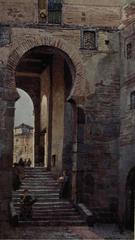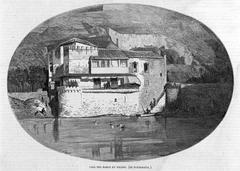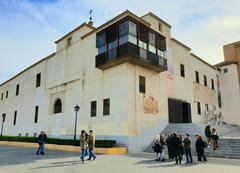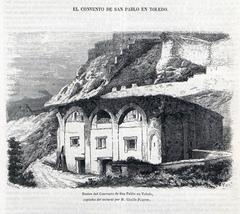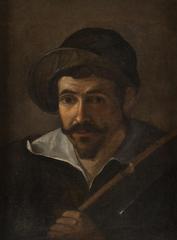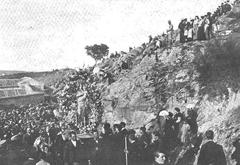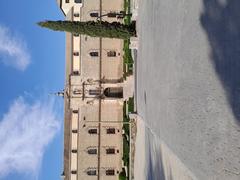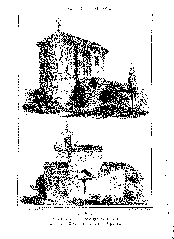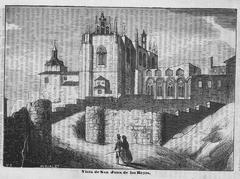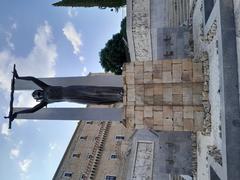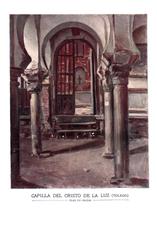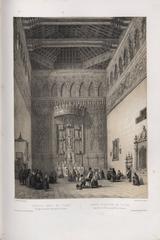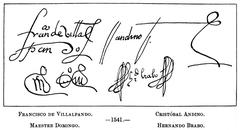Cueva de Hércules Visiting Hours, Tickets, and Toledo Historical Sites Guide
Date: 14/06/2025
Introduction: Toledo’s Underground Marvel
Beneath the storied streets of Toledo, Spain, lies the Cueva de Hércules—a subterranean relic that fuses Roman engineering, centuries of cultural transformation, and enduring legend. Originally constructed in the 1st century CE as a Roman water cistern, this underground marvel has been successively repurposed by Visigothic, Islamic, and Christian civilizations, each leaving unique architectural and cultural marks. Today, the Cueva de Hércules stands not only as a testament to ancient ingenuity but also as a living symbol of Toledo’s multicultural identity and mythic past (Showcaves; Cultura Castilla-La Mancha).
This comprehensive guide explores the Cueva’s origins, historical evolution, architectural highlights, legends, and practical visitor information including current visiting hours and ticket policies. Whether you are a history enthusiast, a lover of legend, or a traveler seeking unique experiences in Toledo, this guide offers everything you need to unlock the secrets of the Cueva de Hércules.
Table of Contents
- Introduction: Toledo’s Underground Marvel
- Roman Origins and Architectural Features
- Layers of History: Visigothic, Islamic, and Christian Transformations
- Myths and Legends: The Cave in Local Lore
- Archaeological Discoveries and Restoration Efforts
- The Cueva in Toledo’s Subterranean Heritage
- Planning Your Visit: Hours, Tickets, and Accessibility
- Events, Exhibitions, and Nearby Attractions
- Frequently Asked Questions (FAQ)
- Summary and Visitor Tips
- Sources and Further Reading
Roman Origins and Architectural Features
The Cueva de Hércules was constructed in the second half of the 1st century CE as a vital part of Roman Toletum’s water infrastructure. This cistern, built with opus caementicium (Roman concrete) and lined with waterproof opus signinum, featured a large rectangular tank once open to the sky before being covered by a robust barrel vault. The system was likely fed by an aqueduct spanning the River Tagus, exemplifying Roman hydraulic mastery (Wikipedia; Consorcio Toledo).
Key features include:
- Barrel-vaulted chamber: Still visible today, it demonstrates advanced Roman engineering.
- Stone and brick construction: Reflects multiple phases, with Roman stonework at the base and later Visigothic and Islamic brickwork above.
- Water channels and niches: Indicative of the cistern’s original use and ongoing modifications.
Layers of History: Visigothic, Islamic, and Christian Transformations
Visigothic Period
After the Roman era, the site became the foundation for a Visigothic Christian temple. Evidence of Visigothic ornamental reliefs survives in the stonework, reflecting the city’s shift to Christianity (Turismo Toledo).
Islamic Toledo
With the Islamic conquest, the structure above the cistern was replaced by a mosque, aligning with Toledo’s prominence as a cultural center in Al-Andalus. Islamic architectural elements, such as horseshoe arches and brick repairs, were introduced to the site.
Medieval Christian Reconquest
Following Alfonso VI’s reconquest in 1085, the mosque was replaced by the Church of San Ginés. The church remained active until the 18th century but was demolished in 1841. Despite these changes above ground, the Roman cistern remained largely intact and continued to intrigue locals and visitors (Showcaves; Turismo Toledo).
Myths and Legends: The Cave in Local Lore
The Cueva de Hércules is deeply intertwined with Toledo’s mythic narrative:
- Hercules as Founder: Legends attribute the cave to Hercules, who, according to local lore, established Toledo and practiced mystical arts in its depths (España Fascinante).
- The House of Locks: Medieval tales describe a sealed chamber, the “Casa de los Candados,” whose forbidden entrance prophesied the city’s fate.
- Don Rodrigo’s Prophecy: The last Visigothic king, Don Rodrigo, is said to have broken the locks and discovered omens of the Muslim conquest, a legend blending history and prophecy.
- Hidden Treasures: Myths abound of secret tunnels, lost relics, and treasures beneath Toledo, fueling ongoing fascination (Consorcio Toledo; Fascinating Spain).
Archaeological Discoveries and Restoration Efforts
Ongoing archaeological work has revealed:
- Ossuaries and artifacts: Excavations from the 16th century onward have uncovered burial remains, pottery, coins, and evidence of continuous use.
- Structural stabilization: Restoration in the early 21st century included reinforcing the vaults, improving lighting, and managing humidity to preserve the site.
- Cultural designation: The cave was declared a Bien de Interés Cultural (BIC) in 2008, ensuring its ongoing protection (Consorcio Toledo).
The Cueva in Toledo’s Subterranean Heritage
Toledo is renowned for its underground networks, including Roman baths, cisterns, and Islamic and Jewish bathhouses. The Cueva de Hércules stands out for its preservation and accessibility, offering insight into the city’s complex water management and multicultural evolution (InSpain.News).
Nearby sites, such as the Roman Baths and Mezquita del Cristo de la Luz, create a rich itinerary for anyone interested in Toledo’s layered history.
Planning Your Visit: Hours, Tickets, and Accessibility
Location
- Address: Callejón de San Ginés, no. 3, Toledo’s historic center (Toledo Guía Turística y Cultural).
- Access: Easily reached on foot from landmarks like the Toledo Cathedral and the Alcázar.
Visiting Hours (as of June 2025)
- Tuesday to Saturday: 12:00–14:00 and 16:00–18:00
- Closed: Sundays, Mondays, and public holidays
- Admission: Free for general entry; no tickets required (Toledo Guía Turística y Cultural).
Guided Tours
- Toledo Underground Experience: Includes the Cueva de Hércules, Roman Baths, and more.
- Duration: ~1.5 hours
- Group Size: Limited; booking in advance is recommended (Veronika’s Adventure).
- Meeting Point: FollowMe Toledo, Zocodover 5
Accessibility
- Physical access: Stairs and uneven floors; not wheelchair accessible.
- Recommendations: Wear sturdy footwear and bring a jacket due to cooler, humid underground conditions.
- Suitability: Children allowed; supervision advised due to steps and narrow passages. Pets are not permitted.
Practical Tips
- Best time to visit: Morning for gentle lighting and fewer crowds.
- Combine with other sites: Plan visits to the Cathedral, Jewish Quarter, and Roman Baths for a comprehensive experience.
- Check for exhibitions: The cave hosts rotating art and cultural events (Toledo Guía Turística y Cultural).
Events, Exhibitions, and Nearby Attractions
The Cueva de Hércules is an active cultural space, hosting temporary art exhibitions and events. In 2025, for example, it features the IV Edición de Artista Singular “Cronología” by Odnoder. Nearby, discover:
- Toledo Cathedral
- Alcázar of Toledo
- Mezquita del Cristo de la Luz
- Jewish Quarter
- Museo del Greco
These sites are within easy walking distance, making the cave an ideal anchor point for exploring Toledo’s heritage (Nomads Travel Guide).
Frequently Asked Questions (FAQ)
Q: What are the Cueva de Hércules visiting hours?
A: Tuesday to Saturday, 12:00–14:00 and 16:00–18:00. Closed Sundays, Mondays, and public holidays.
Q: Is there an entrance fee?
A: No, general admission is free.
Q: Are guided tours available?
A: Yes, as part of the Toledo Underground experience. Advance booking is recommended.
Q: Is the cave accessible for people with reduced mobility?
A: Due to stairs and uneven surfaces, it is not fully accessible.
Q: Can I take photographs inside?
A: Photography is permitted; avoid flash where possible.
Q: Are pets allowed?
A: No, pets are not permitted.
Summary and Visitor Tips
The Cueva de Hércules is a must-see for anyone interested in Toledo’s unique blend of history, legend, and architecture. Its Roman origins, subsequent adaptations, and legendary associations with Hercules and Don Rodrigo make it a symbol of the city’s multicultural and mysterious past. Admission is free, and its central location makes it easy to incorporate into a broader exploration of Toledo’s World Heritage-listed old town. For a richer experience, join a guided tour and stay updated on temporary exhibitions and events. Always consult official tourism sources for the latest visiting hours and policies (Consorcio Toledo; Toledo Guía Turística y Cultural; Veronika’s Adventure).
Sources and Further Reading
- Showcaves
- Cultura Castilla-La Mancha
- Consorcio Toledo
- Turismo Toledo
- España Fascinante
- Nomads Travel Guide
- Toledo Guía Turística y Cultural
- Veronika’s Adventure
- Patrimonio Histórico de Toledo
